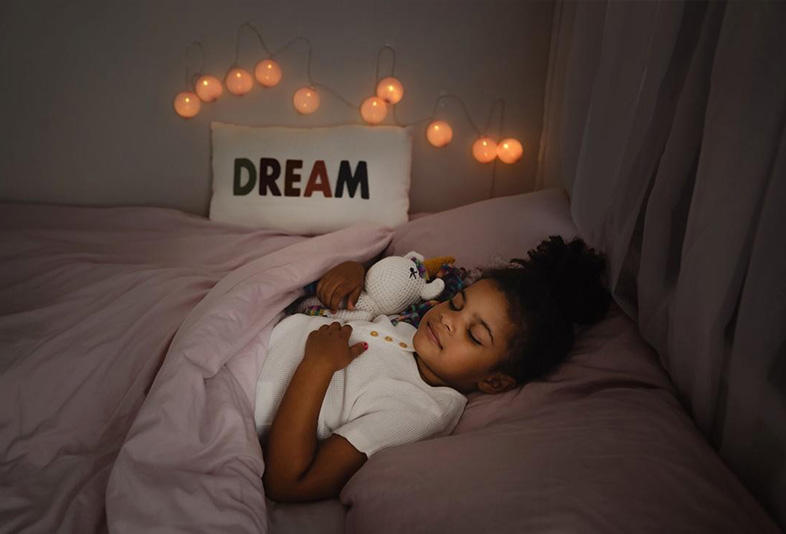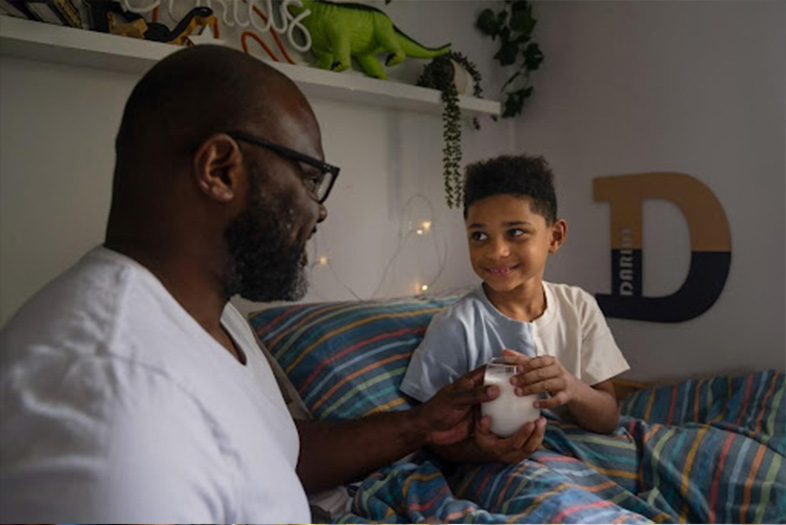Getting a good night’s sleep is crucial for your child’s growth and development, yet many children have problems sleeping.
You know how tough it is to see your little one struggling with tiredness, so it’s good to know that setting a good bedtime routine for kids and creating a calm and nurturing bedroom environment can really help.
We spoke with child sleep expert Jo Tantum on how to create a relaxing bedtime routine that will help your child fall asleep.
What is a bedtime routine?
A bedtime routine is a set of calm, repeated actions that you do with your child every night before they go to sleep. Their repetitive nature, and the fact that your child will come to find them familiar, can relax your child and help them realise it’s time for sleep. It also gives them a sense of security.
Why is a bedtime routine important for a child?
Children who have a good, consistent bedtime routine have been shown to go to sleep more easily by themselves, get to sleep quicker and stay asleep longer than those who don’t have a set routine.
They also wake up less, which means they won’t disturb you either. All of this, of course, results in better quality sleep and a better rested child.
A good bedtime routine for your child also has other benefits.
Jo continues: “Children who have good sleep patterns will be more emotionally engaging, so this will lead to fewer outbursts and meltdowns.”
“Well-rested children will also be more likely to listen to instructions and carry out tasks asked of them. Their appetite will be better and they won’t crave sweet things to help them stay awake.”
“They will more likely get ready themselves for nursery or school, which is of course less stressful for you. When they are there, they will be more attentive and therefore retain more information.”
Setting a good bedtime routine for kids
“Here is how to set a good bedtime routine.” says Jo. “You can tweak some of the items in this list but generally speaking, they work and if you repeat them time after time, your child will know what’s expected of them from an early age.”
1. Decide on a set bedtime (with some leeway)
Decide what bedtime is appropriate for the age of your child.
- Under a year, bedtime should be around 6:00pm.
- From one to two years, 6:00-6:30pm.
- From three to five years, 7:15-8:20pm.
- From six to 13 years, 7:15-9:00pm.
You might allow kids to stay up a little later at weekends and on holiday but they really do need their sleep.
On the plus side, think of that lovely long uninterrupted evening the adults have.
2. Start the calm-down
Turn off any TVs, games or electronic devices and remove them from their bedroom. Turn on soft lights and lullabies, so that when they return after their bath, it’s calm and peaceful.
3. Make sure they’re fed!
Make sure your child has recently had a good, nutritious meal or snack. If they are still breast or bottle fed, they should have a feed just before bed.
4. Give them a warm bath
Next, a warm and relaxing bath will help them start to settle down for the night. Make sure your kids have gone to the loo for the last time before bed.
If your child is concerned about night time accidents, it’s time to pop them in DryNites® Pyjama Pants, or place a DryNites® Bed Mat on the bed.
5. Brush their teeth
It’s time to make sure they brush their teeth just after they have put their night clothes on. This prevents tooth decay.
6. Read them their favourite book(s)
Let your child choose a favourite book, and read them a story. Ones with repetitive themes are particularly great for bedtime—and you should always finish with an old favourite.
7. Turn down the lights, it’s time for sleep
Now it’s time to turn down the lights, put on some white noise or a lullaby machine and say good night. Give them a kiss and a cuddle and leave the room.

The Dos and Don’ts of bedtime routines
With all that in mind, it’s a good idea to remember some dos and don’ts around bedtime routines, to help you stick to some rules.
Do…
- have a consistent routine each evening.
- leave the room when they’re sleepy, not asleep—this helps them fall asleep on their own.
- keep it fairly short.
- repeat a shorter version for daytime naps.
- follow safe sleep guidelines.
Don’t…
- allow screens or games in the bedroom, as blue light can harm sleep.
- get them too excited – bath time and playtime at night should be calm.
- read scary stories at bedtime. Stick to old favourites with reassuring themes.
- let them have a lie-in at weekends; this can lead to a disturbed routine at night.
- let them get over-tired before you start the routine. If they’re already sleepy, or you’ve been out and they slept in the car, put them straight to bed after a tooth clean.
- offer snacks that will keep them awake – anything with caffeine or sugar is a bad idea!
An example bedtime routine for a 3-year-old child
It's time to put everything you've learned into practice. To show you how simple it can be to put together a bedtime routine, we've created one you might use for a 3-year-old child.
- Set their bedtime for 7:30pm.
- Turn off the TV or any electronic devices (including your phone that they might be playing on!) by 6:30pm.
- Give them a warm bath.
- Help them brush their teeth and go to the toilet.
- Get them dressed for bed, with their DryNites® Pyjama Pants on.
- Read them their favourite bedtime stories.
- Put on a night-light.
- Play a lullaby to send them off to sleep.
- Kiss them goodnight and wish them pleasant dreams.
After a few evenings repeating this same routine, you and your child will get into a rhythm. Your child may even start to expect and anticipate the next step, as the two of you form a healthy bedtime habit.
Give it time, and a bedtime routine like this can help remove uncertainty around bedtimes, setting your child up for a restful night's sleep.
When to start a bedtime routine for your child
“The first few weeks are very tiring,” Jo explains, “so having a simple bedtime routine at the end of the day can be relaxing and reassuring for your baby.”
“Some things may interrupt the routine you’ve set, such as separation anxiety in toddlers, night terrors and of course bedwetting,” Jo explains. “But each time something like this happens, try to get the routine back on track the next night as much as possible, as sleep is so important.”
“Make sure you explain each part of the bedtime routine to your child as you go along,” says Jo. “Kids love routine and boundaries and like to know what to expect.”
Build a calming bedtime routine that encourages your child to go to sleep, worry-free
“This is a special time for you and your child,” says Jo. “You can chat about your day, find out what they did at nursery or school and also find out if anything is worrying them."

One of those worries might be night-time accidents.
If your child is wetting the bed at night, DryNites® Bed Mats and Pyjama Pants can easily be included as part of that routine. A Bed Mat can be laid out before bed or your child can put on Pyjama Pants at the same time they change into their pyjamas.
It won't stop bedwetting, but it can help them go to sleep worry-free, stay dry at night and wake up awesome! It's a small addition to their routine, and just one of the ways you can support your child through the bedwetting phase.
To discover more ways to support your child at night, explore our collection of bedwetting advice and night-time guidance.
From helping create a relaxing bedroom environment to all the information you need on the causes of and reasons for bedwetting, we're here to help.




 your parenting partner
your parenting partner